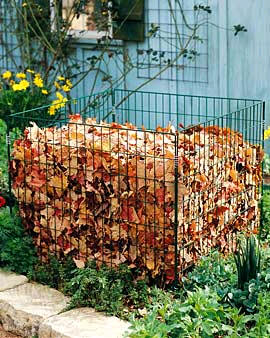Building A Compost Bin
It is not necessary to purchase a compost bin before creating. While doing so provides benefits and ease of use, for many people it may not be economically feasible. Building a compost bin from items around the house or farm is quite easy. If you're looking for a more pleasing look for your homemade compost bin, and you're a handyman with building, then view the plans below for the construction of a wooden compost bin.
 Wire
Bin
Wire
Bin
Use an 11-foot length of 2-inch x 4-inch x 36-inch welded, medium-gauge fence wire from your local hardware or building supply store. Tie the ends together to form your hoop. A bin this size holds just over one cubic yard of material. Snow fencing can be used in a similar fashion. Another option is our Wire Bin Composter, which holds 20 cubic feet. In addition, it can be expanded to form a three-bin unit.
Trash Can Bin
To convert a plastic trash can into a composter, cut off the bottom with a saw. Drill about 24 quarter-inch holes in the sides of the can for good aeration. Bury the bottom of the can from several inches to a foot or more below the soil surface and press the loosened soil around the sides to secure it. Partially burying the composter will make it easier for microorganisms to enter the pile.
Block or Brick or Stone Bin
Lay the blocks, with or without mortar, leaving spaces between each block to permit aeration. Form three sides of a 3-to 4-foot square, roughly 3 to 4 feet high.
Wood Pallet Bin
Discarded wooden pallets from factories or stores can be stood upright to form a bin. Attach the corners with rope, wire, or chain. A fourth pallet can be used as a floor to increase air flow. A used carpet or tarp can be placed over the top of the pile to reduce moisture loss or keep out rain or snow.
Two or Three-Bay Wood Bin
Having several bins allows you to use one section for storing materials, one for active composting, and one for curing or storing finished compost. Each bin should be approximately 36 x 36 x 36 inches. Be sure to allow air spaces between the sidewall slats, and make the front walls removable (lift out slats) for easy access. Lift-up lids are nice. You can extend the life of your wood bin by treating it with a non-toxic weatherproofing substance such as Thompson's Water Seal.
There are methods to keep your compost aerated, without the hassle of turning:
- Build your pile on a raised wood platform, such as a wood pallet, or on a pile of branches.
- Make sure there are plenty of air vents in the sides of your compost bin.
- Place a couple of perforated 4" pcv pipes in the center of your compost pile.
Did you Know!?
That adding compost to your soil can be a natural form of pest control for termites, look for more termite facts at Orkin.com today, and learn how get rid of those pesky mites.
Similar Composting
Articles
Composting |
Composters | Compost
Bins | Compost Tumblers
Popular Composting Products
Composting |
Compost Accessories |
Compost Pails |
Compost Systems |
Worm Bins
-


Think Four Seasons: When designing your backyard landscape, remember that there are four seasons. You will want flowers and shrubs which bloom during different times of the season, autumn foliage during the fall, and a structure that can withstand the winter.


-


Plan before you dig a water garden. Before you even start to think of digging to put in a water garden, make sure you plan everything in advance. Dimensions, the type of water garden you want to have, how deep it will need to be and if you need any permits to do so. If in doubt, call a professional out to help you. That's why they are there.


-


Get the right supplies for the job. Make sure you always get the exact right supplies you need for the job at hand. Don't skimp on quality when you are landscaping your backyard as you will pay dearly for it in the long run.

